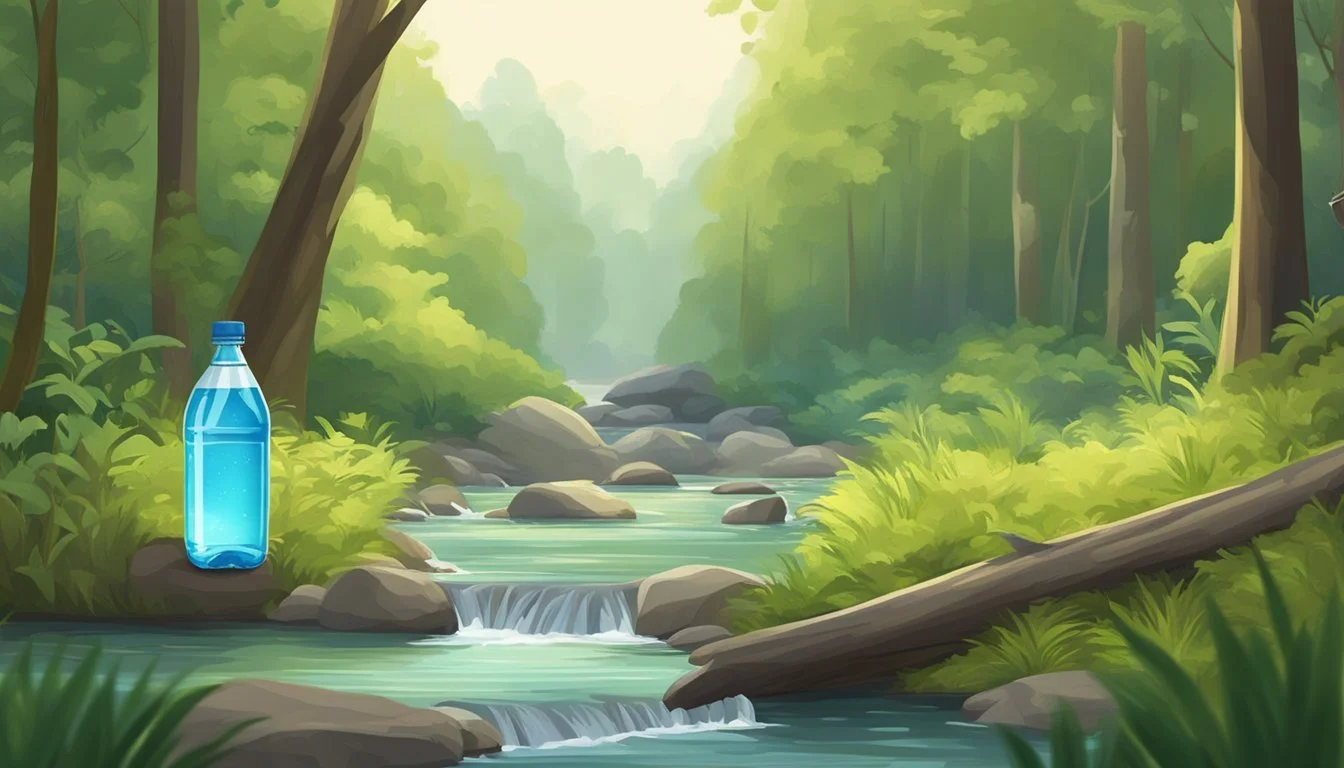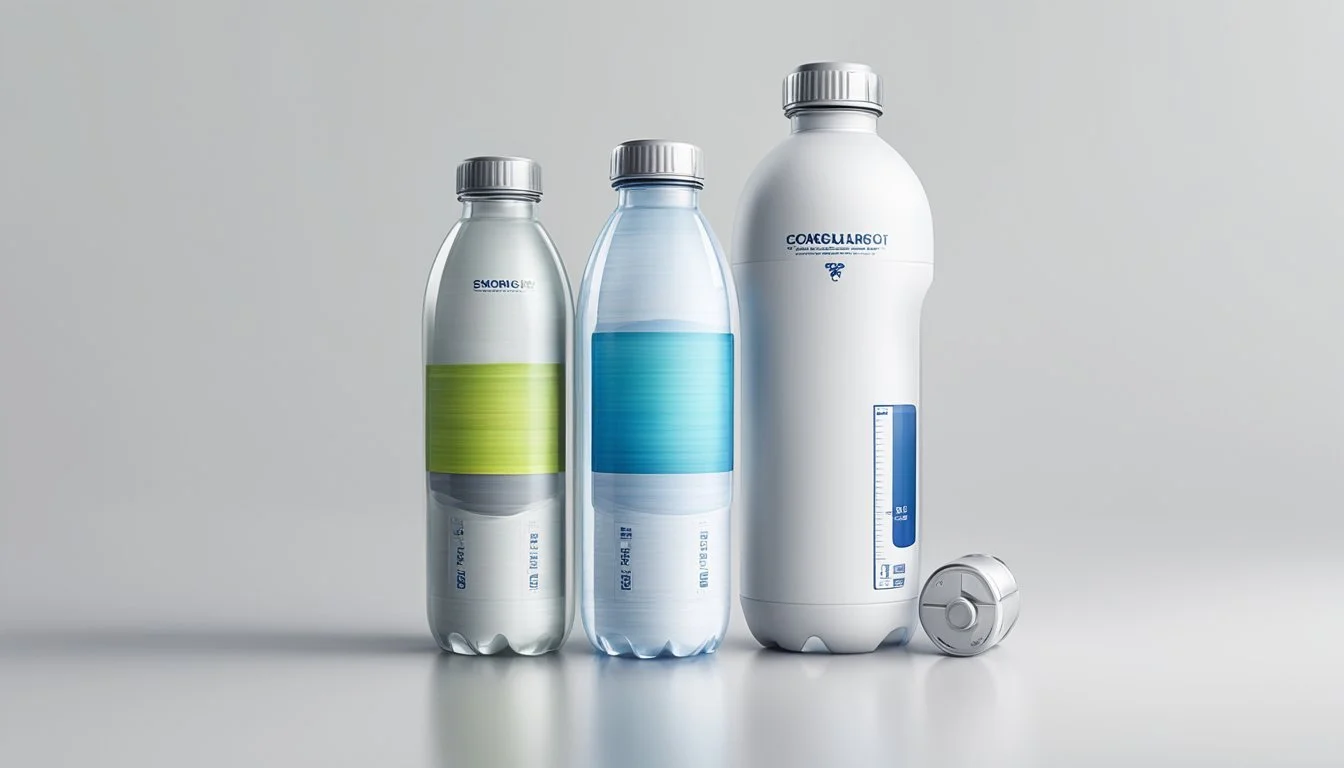Deer Park vs. Aqua Carpatica
Comparing Purity, Taste, and Value
When it comes to choosing bottled water, discerning consumers often weigh their options carefully. Deer Park, a Nestlé brand, is celebrated for its 100% natural spring water sourced from various springs along the Eastern Seaboard of the United States, providing a crisp and clean taste. This iconic brand prides itself on the purity and consistency of its product, making it a reliable choice for those prioritizing natural hydration.
In contrast, Aqua Carpatica offers a unique selling point with its high natural mineral content and zero nitrates, sourced from untouched springs in the Carpathian Mountains. This ensures not only a refreshing taste but also an added layer of health benefits, appealing to those looking for more than just hydration. The brand's commitment to purity and transparency sets it apart in the crowded bottled water market.
For those deciding between Deer Park and Aqua Carpatica, it ultimately comes down to a preference for natural spring water's simplicity versus mineral-rich content's potential health benefits. Whether you prioritize the natural taste and provenance of Deer Park or the enriched and pristine water of Aqua Carpatica, both brands offer unique advantages that cater to different hydration needs and preferences.
Background of Bottled Water
Bottled water has a rich history and has evolved significantly over time. The modern bottled water industry features a diverse range of brands and water sources, with both natural spring waters and purified water options available.
History and Evolution
The history of bottled water dates back to the Roman Empire, where water was transported in clay bottles. During the 17th century, the first commercially bottled water began in Europe, with companies like Spa in Belgium marketing mineral water for its health benefits.
The 19th century saw the rise of bottled water in America, with Saratoga Springs becoming a popular brand. Advancements in glass manufacturing and bottling technology allowed for wider distribution and improved hygiene.
In the late 20th century, plastic bottles revolutionized the industry by reducing production costs and increasing portability. This period also saw the emergence of many prominent bottled water brands such as Evian, known for its natural spring water sourced from the Alps.
Modern Bottled Water Industry
Today's bottled water industry is vast and diverse, with brands offering water from various sources, including natural springs, wells, and municipal supplies. Brands like Deer Park and Poland Spring emphasize their natural spring water sources, while others like Aquafina utilize advanced purification processes.
Consumer preference for bottled water has surged due to increasing concerns about tap water quality and the convenience of bottled water. As a result, the market has expanded to include a range of products, from basic purified water to premium bottled waters with added electrolytes and minerals.
The rise of eco-conscious consumers has led to innovations in sustainable packaging, with some brands opting for biodegradable bottles or recycled materials. The industry continues to adapt, driven by changing consumer preferences and advancements in water purification and packaging technology.
Profile of Deer Park
Deer Park is recognized for its natural spring water sourced from various locations along the Eastern Seaboard of the United States. This brand emphasizes maintaining high standards of quality and purity, ensuring a fresh and clean drinking experience.
Origin and Source
Deer Park draws its water from several natural springs located along the Eastern Seaboard. These springs include sources in Pennsylvania, Maryland, and other surrounding areas. The regional sourcing is a key aspect of Deer Park's identity, highlighting its commitment to providing water that retains the natural characteristics of its origin.
With a focus on sustainable practices, Deer Park ensures that the spring water is harvested responsibly. They use methods that aim to preserve the environmental health of these natural sources. This approach not only benefits the ecosystem but also guarantees that the water remains pure and untouched by contaminants typically found in tap water.
Quality and Purity Standards
Deer Park adheres to stringent quality and purity standards mandated by the FDA and the EPA. These regulations ensure that the water is safe for consumption and free from harmful substances. Each batch of water undergoes rigorous testing to meet these high standards.
The bottling process includes multi-step filtration, which removes impurities while retaining essential minerals. This ensures that the water delivered to consumers is not only safe but also nutritious. Deer Park also prides itself on its clear and crisp taste, a result of the careful handling and processing of its natural spring water.
By following these strict guidelines, Deer Park maintains the trust and satisfaction of its customers, providing a reliable source of clean and refreshing water.
Profile of Aqua Carpatica
Aqua Carpatica is a distinguished bottled water brand sourced from the Carpathian Mountains. Known for its purity and remarkable mineral content, it boasts compliance with stringent quality standards.
Origin and Source
Aqua Carpatica originates from the pristine Carpathian Mountains in Romania. These mountains, characterized by their ancient forests and untouched natural beauty, offer an ideal source for high-quality spring water. The brand emphasizes its natural origin, ensuring that the water is collected from springs located deep within the mountains.
The Carpathian region’s unique geological formations contribute to the water's mineral composition, making Aqua Carpatica distinct. The company's commitment to maintaining the natural qualities of this water source is evident in their careful sourcing practices.
Quality and Purity Standards
Aqua Carpatica prides itself on meeting and exceeding stringent quality and purity standards. The water is tested rigorously to ensure it meets both EPA and FDA regulations for bottled water. It is noted for being nitrate-free, a significant health benefit, particularly for pregnant women and young children.
The brand's naturally low sodium levels and balanced mineral content contribute to its clean taste and health benefits. Aqua Carpatica’s adherence to high quality and purity standards ensures that consumers receive a product that is both safe and beneficial for everyday consumption. The focus on purity from source to bottle underscores the brand's reputation for premium bottled water.
Comparative Analysis of Deer Park and Aqua Carpatica
When comparing Deer Park and Aqua Carpatica bottled waters, key factors include their mineral content, taste profiles, packaging sustainability, and price points. These elements determine the overall value and appeal to different consumer needs and preferences.
Mineral Content and Health Benefits
Deer Park is branded as 100% natural spring water sourced from various springs in the Eastern United States. It is generally marketed for its crisp taste and purity.
Aqua Carpatica, sourced from the Carpathian Mountains, is known for its exceptionally low nitrate levels and balanced mineral content. High in calcium and magnesium, it promotes hydration and overall health benefits.
Mineral Deer Park Aqua Carpatica Calcium Moderate High Magnesium Moderate High Sodium Low Very Low Nitrates Low Very Low
Taste Profile and Preference
Deer Park offers a clean, crisp taste attributed to its natural spring sources. It is often described as refreshing, making it a popular choice for many consumers.
Aqua Carpatica, with its low mineralization and balanced pH, provides a smooth and neutral taste. This refined profile appeals to those who prefer a subtle flavor in their bottled water.
Consumer taste preferences vary, with some favoring Deer Park's more "natural" taste and others preferring the gentle, almost imperceptible taste of Aqua Carpatica.
Packaging and Sustainability
Deer Park primarily uses plastic bottles, which pose sustainability concerns. Despite recycling programs in place, plastic remains an environmental challenge.
Aqua Carpatica, on the other hand, offers options in both plastic and glass bottles. Glass packaging is often considered more environmentally friendly, reducing plastic waste and appealing to eco-conscious consumers.
Aspect Deer Park Aqua Carpatica Material Plastic Plastic, Glass Sustainability Moderate High (for glass option)
The emphasis on glass bottling by Aqua Carpatica marks a significant step towards sustainability, aligning with increasing environmental awareness.
Price Comparison and Value
Deer Park is positioned as a budget-friendly option, making it accessible to a wide range of consumers. Its price point reflects its everyday water status without significant premium features.
Aqua Carpatica, with its premium branding, tends to be more expensive. The higher price can be attributed to its sophisticated mineral content, unique source, and glass bottle option.
Brand Price Point Value Proposition Deer Park Lower Affordable, everyday hydration Aqua Carpatica Higher Premium quality, low nitrates, eco-friendly
While Deer Park offers affordability and reliable quality, Aqua Carpatica provides added health benefits and sustainable packaging at a higher cost.
Health and Safety Standards
Deer Park and Aqua Carpatica both prioritize health and safety. They employ distinct purification processes and adhere to regulatory standards to ensure clean and safe drinking water.
Purification Processes
Deer Park sources its water from natural springs and ensures its purity through rigorous filtration methods. They use activated carbon and microfiltration to remove impurities, and they employ ozone sterilization for disinfection.
Aqua Carpatica, known for its naturally occurring minerals, undergoes minimal processing. The water is naturally filtered through layers of volcanic rock, which enhances its purity. Aqua Carpatica also uses ultraviolet (UV) light treatment to eliminate harmful microbial contaminants.
Regulatory Compliance
Both brands follow strict regulatory guidelines set by agencies like the FDA and EPA.
Deer Park meets or exceeds federal and state standards for bottled water. They regularly test their water to ensure compliance with safety standards, including limits on contaminants like heavy metals and microorganisms.
Aqua Carpatica complies with the European Union’s water safety standards. Their products are frequently tested for compliance with arsenic, nitrate, and other harmful substances to ensure they meet strict health criteria.
Identifying Contaminants
Identifying and managing contaminants is crucial for both brands to ensure water safety.
Deer Park undergoes regular testing for a range of contaminants, including PFAS chemicals, which are known for their potential health risks. The company ensures these levels remain within safe limits as per regulatory guidelines.
Their water also undergoes stringent tests for substances like arsenic and heavy metals.
Aqua Carpatica focuses on maintaining low nitrate levels due to their potential health risks. Their water is free from impurities like PFAS and other hazardous chemicals. Aqua Carpatica places a strong emphasis on transparency, regularly publishing water test results to confirm their purity levels meet safety standards.
Environmental and Ethical Considerations
When comparing Deer Park to Aqua Carpatica, two important factors to examine are environmental impact and corporate social responsibility. These aspects are crucial for understanding the broader implications of choosing one brand over another.
Environmental Impact of Bottled Water
Bottled water production has significant environmental impacts, including plastic waste and resource consumption. Deer Park sources its water from multiple springs across the Eastern United States and utilizes plastic bottles. To mitigate some environmental concerns, they offer recycling programs and promote reduced plastic use. However, the transport and packaging systems still contribute to pollution and carbon emissions.
Aqua Carpatica markets its water as coming from untouched springs in the Carpathian Mountains. They emphasize purity and minimal processing. Aqua Carpatica also uses BPA-free bottles and advocates for better recycling practices. Nonetheless, the extensive shipping required to distribute this water globally also raises concerns about carbon footprint and environmental sustainability.
Corporate Social Responsibility
Corporate social responsibility (CSR) reflects a company's commitment to ethical practices and community contributions. Deer Park, owned by BlueTriton Brands, engages in community initiatives and environmental conservation efforts. They support natural habitat preservation projects around their source springs. Despite these efforts, the parent company's broader practices have faced scrutiny over resource extraction and environmental impact.
Aqua Carpatica prides itself on sustainable sourcing and environmental stewardship. They focus on maintaining the pristine quality of their source water and minimizing their ecological footprint. Aqua Carpatica also supports local communities by providing safe drinking water and environmental education.
Both brands have made strides in CSR, but challenges remain. Enduring commitment to sustainability and responsible resource management is essential for both companies to maintain ethical standards.
Consumer Guidance
Navigating the bottled water aisle can be daunting with numerous brands like Aquafina, Evian, Fiji, and Smartwater. Knowing how to read labels and understanding key terms can help consumers make informed choices.
Understanding Labels and Terms
Labels on bottled water provide crucial information regarding its source, filtration process, and mineral content. Deer Park water is sourced from natural springs, whereas Aqua Carpatica boasts low mineral content and natural gas-free spring water.
Consumers should look for terms such as "purified," "spring water," and "mineral water." Purified water, like Aquafina, undergoes rigorous filtration but may lack natural minerals. Spring water maintains natural mineral content, offering a different taste profile, as seen with Evian and Fiji. Identifying these terms helps determine which water meets their health and taste preferences.
Making Informed Choices
When choosing between Deer Park, Aqua Carpatica, or other brands, consumers should consider their specific needs, such as mineral content or taste. Deer Park's natural spring water appeal is highlighted by its regional sourcing from the Eastern Seaboard. Aqua Carpatica, on the other hand, is valued for its naturally low nitrate levels and balanced pH.
Checking the source and mineral content on the label can indicate potential health benefits. Some may prefer low-sodium options, like Smartwater, for dietary reasons. Reading reviews and understanding the brand’s commitment to quality ensures that the selected water meets personal standards.
By carefully evaluating labels and understanding different water types, consumers will make choices that align with their health goals and taste preferences.
Conclusion
When comparing Deer Park and Aqua Carpatica bottled water, several factors come into play that affect consumer choices.
Taste and Quality:
Deer Park is known for its crisp, clean taste derived from natural springs along the Eastern Seaboard of the United States. Aqua Carpatica boasts a naturally nitrate-free and low sodium water, often appealing to those seeking purity.
Hydration:
Both brands provide excellent hydration. Deer Park’s natural spring water and Aqua Carpatica’s mineral-rich content both contribute effectively to maintaining hydration levels.
Sustainability:
Considering the source and environmental impact, Deer Park highlights its natural spring sources. On the other hand, Aqua Carpatica emphasizes eco-friendly practices in its bottling process, which can be a factor for environmentally conscious consumers.
Bottom Line:
Personal preferences play a significant role. Those prioritizing taste may lean toward Deer Park, while Aqua Carpatica may attract individuals focused on purity and low sodium content.
Consumer Choices:
Consumers need to weigh these aspects to decide which water suits their lifestyle and priorities. Both brands offer quality hydration solutions, but the deciding factors remain individual taste, quality preferences, and sustainability concerns.
More About Deer Park
Deer Park vs Cascade Mountain: Which Bottled Water is Better?
Deer Park vs Hawaii Volcanic: Which Bottled Water is Better?
Deer Park vs Hawaiian Springs: Which Bottled Water is Better?
Deer Park vs Icelandic Glacial: Which Bottled Water is Better?
Deer Park vs Kirkland Signature: Which Bottled Water is Better?
Deer Park vs Mountain Valley Spring Water: Which Bottled Water is Better?
Deer Park vs Nestle Pure Life: Which Bottled Water is Better?
Deer Park vs Richard's Rainwater: Which Bottled Water is Better?
Deer Park vs Solan de Cabras: Which Bottled Water is Better?
Deer Park vs Talking Rain AQA: Which Bottled Water is Better?
Deer Park vs Whole Foods 365: Which Bottled Water is Better?
Deer Park vs Whole Foods Italian Still Mineral water: Which Bottled Water is Better?
More About Aqua Carpatica
Acqua Pana vs Aqua Carpatica: Which Bottled Water is Better?
Aqua Carpatica vs Alkaline88: Which Bottled Water is Better?
Aqua Carpatica vs Cascade Mountain: Which Bottled Water is Better?
Aqua Carpatica vs Castle Rock: Which Bottled Water is Better?
Aqua Carpatica vs CBD Living: Which Bottled Water is Better?
Aqua Carpatica vs Crystal Geyser: Which Bottled Water is Better?
Aqua Carpatica vs Crystal Lake: Which Bottled Water is Better?
Aqua Carpatica vs Essence pH10: Which Bottled Water is Better?
Aqua Carpatica vs Hawaii Volcanic: Which Bottled Water is Better?
Aqua Carpatica vs Hawaiian Springs: Which Bottled Water is Better?
Aqua Carpatica vs Kirkland Signature: Which Bottled Water is Better?
Aqua Carpatica vs Liquid Death: Which Bottled Water is Better?
Aqua Carpatica vs Open Water: Which Bottled Water is Better?
Aqua Carpatica vs Proud Source: Which Bottled Water is Better?
Aqua Carpatica vs Purely Sedona: Which Bottled Water is Better?
Aqua Carpatica vs Richard's Rainwater: Which Bottled Water is Better?
Aqua Carpatica vs Simple Truth: Which Bottled Water is Better?
Aqua Carpatica vs Solan de Cabras: Which Bottled Water is Better?
Aqua Carpatica vs Talking Rain AQA: Which Bottled Water is Better?
Aqua Carpatica vs Weird Water: Which Bottled Water is Better?
Aqua Carpatica vs Whole Foods 365: Which Bottled Water is Better?
Aqua Carpatica vs Whole Foods Italian Still Mineral water: Which Bottled Water is Better?
Boxed Water vs Aqua Carpatica: Which Bottled Water is Better?
Core Hydration vs Aqua Carpatica: Which Bottled Water is Better?
Ice Mountain vs Aqua Carpatica: Which Bottled Water is Better?
Icelandic Glacial vs Aqua Carpatica: Which Bottled Water is Better?
Just Water vs Aqua Carpatica: Which Bottled Water is Better?
Mountain Valley Spring Water vs Aqua Carpatica: Which Bottled Water is Better?
Nestle Pure Life vs Aqua Carpatica: Which Bottled Water is Better?
Poland Spring vs Aqua Carpatica: Which Bottled Water is Better?
San Pellegrino vs Aqua Carpatica: Which Bottled Water is Better?
Smartwater vs Aqua Carpatica: Which Bottled Water is Better?
Topo Chico vs Aqua Carpatica: Which Bottled Water is Better?
Zephyrhills vs Aqua Carpatica: Which Bottled Water is Better?







